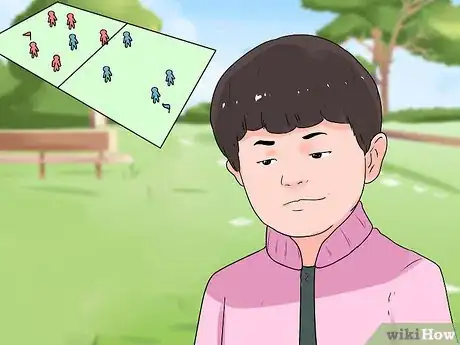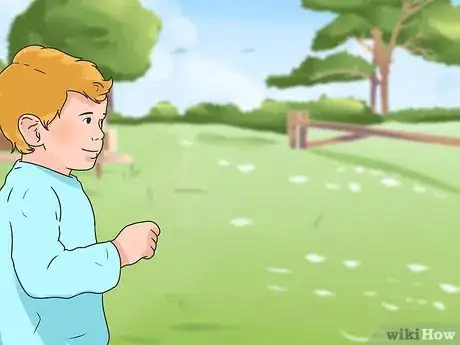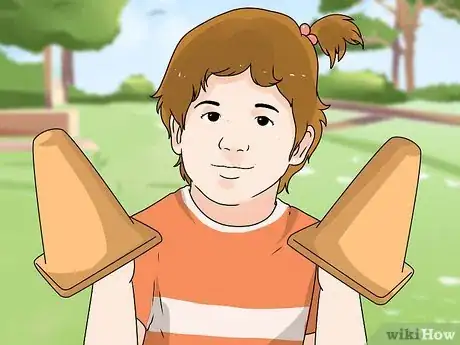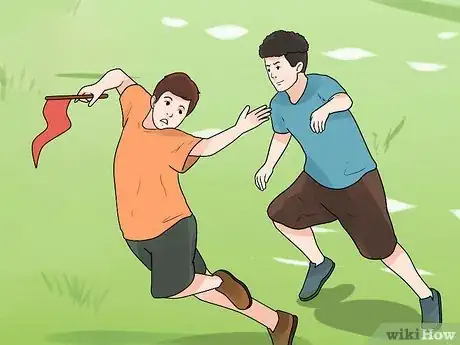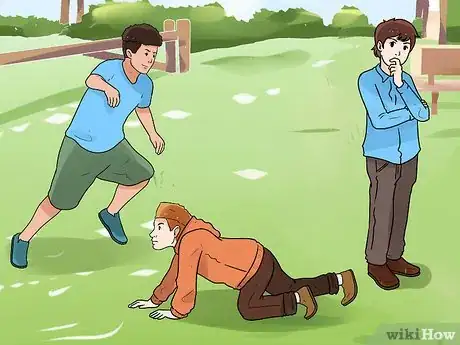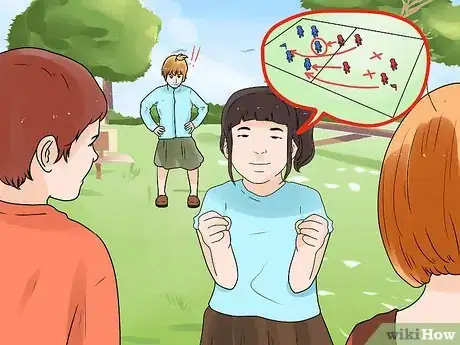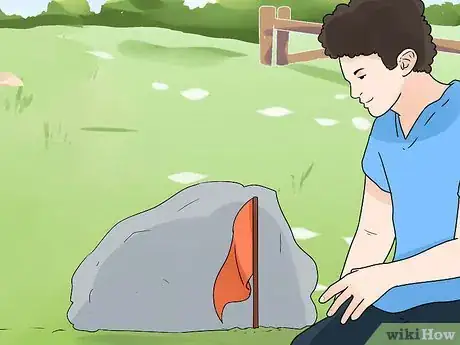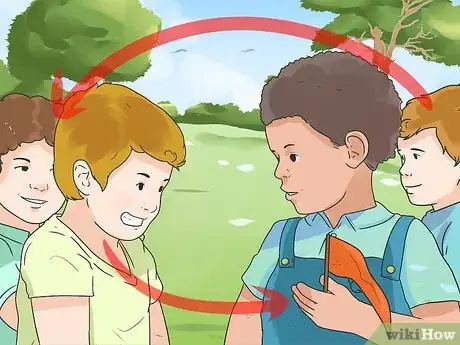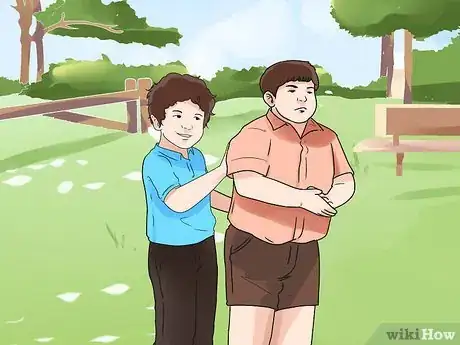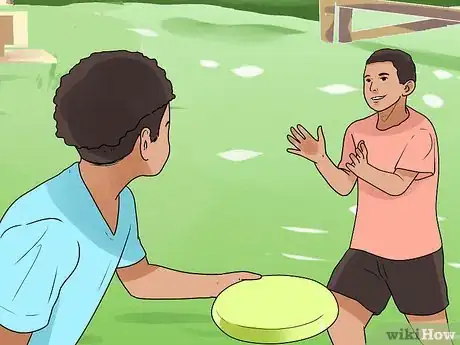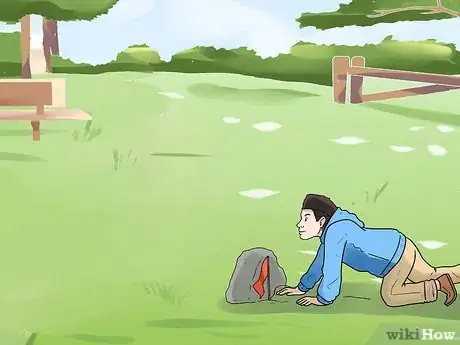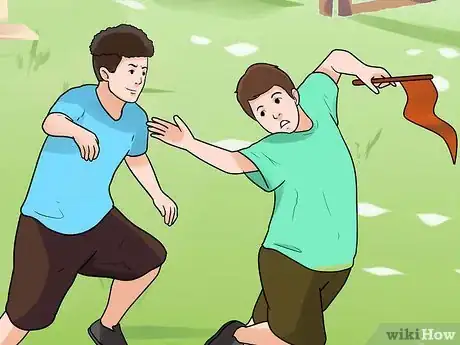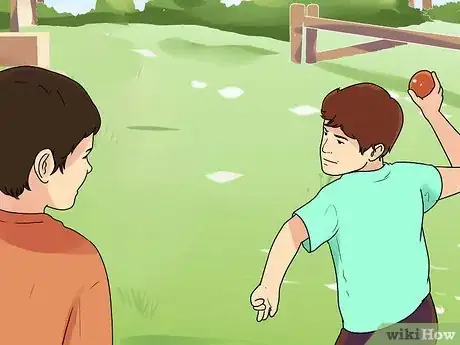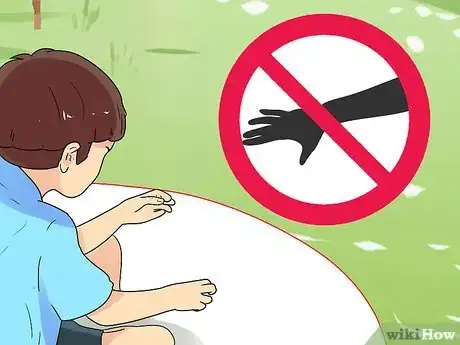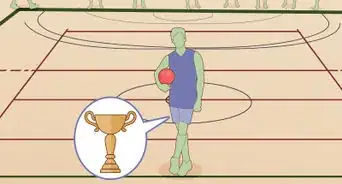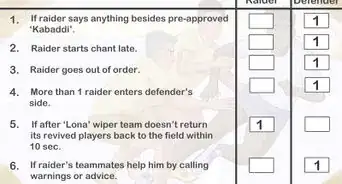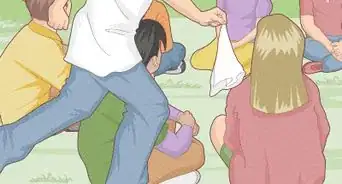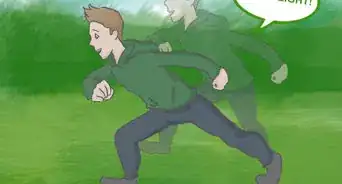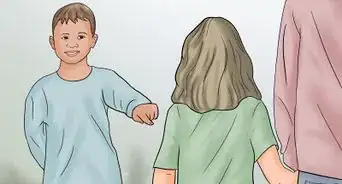wikiHow is a “wiki,” similar to Wikipedia, which means that many of our articles are co-written by multiple authors. To create this article, 57 people, some anonymous, worked to edit and improve it over time.
wikiHow marks an article as reader-approved once it receives enough positive feedback. This article has 20 testimonials from our readers, earning it our reader-approved status.
This article has been viewed 604,240 times.
Learn more...
Capture the flag is hard to set up, but incredibly fun and complex to actually play. If you have at least 8 people, a large piece of land to play on, and two flags, you're already ready to go. The goal is to grab the enemy team's hidden flag and bring it back to your side -- but if you get tagged in enemy territory you're off to jail. The first team to steal the other's flag wins.
Steps
Preparing to Play
-
1Know the basics of capture the flag to get playing quickly. In capture the flag, two teams hide an object ("the flag") on their territory. Most of the time, the territory is made by splitting a playing area in half with cones, trees, or other markers. Your team tries to take the opponents' flag and bring it back to your territory before they find yours. To defend your flag, you can tag any opponent on your territory and send them to "jail" until they are tagged by their teammate to be set free. The first team to capture the other's flag wins the round. If the game was quick you usually switch sides, re-hide the flags, and play again.
- Teams are even, made up frequently of 5 people or more per team.
- You need a large area to play in, otherwise it is too difficult to explore the opponent's territory without immediately getting tagged.
-
2Find a large, open area to play. You need plenty or room to run around and places to hide the flag. Lots of obstructions and obstacles, allowing you to hide as you search for the opponents flag, can make the can more fun as well. Try to pick an area with a large obstruction near the center so no guards can see all the way across the field. Some great spots include:
- A house with a large front and back yard, or two equally large sides.
- A paintball course.
- A large stretch of woods, especially with a stream or set of power lines in the middle.[1]
- You can play a modified version of capture the flag on completely flat ground as well. To do so, you simply place the flags at the farthest possible ends of the field in plain sight. Split the field in half, then start playing. The game then becomes more about running, dodging and tagging than hiding.
Advertisement -
3Find an even number of people to play with. You can play with any number of people, but it is best with at least 10 or 12. This way you have two even teams of 5 or 6. If possible, try and find a way to separate the teams with different color shirts, hats, or bandanas.
- You can still play with an uneven number of players. Have the extra player hide the flags by themselves, for example, so neither team knows where to look. They can then "judge" the game, officiating whether or not someone was tagged. You can also make it so that the team with the "better territory" (for example, a backyard with many more hiding spots) has one less player, evening the playing field.
-
4Choose two similar objects to be flags. These just need to be two objects of similar size and shape. If you are playing at night it is best to have something light colored. Some good options include:
- Bandanas.
- Old t-shirts.
- Balls and Frisbees (you may make a rule that they can be passed once found, or they have to be carried)
- Cones
- Old toys.
-
5Mark all of the boundaries of the playing field together. First and foremost, designate the center line dividing your territory. It is often easiest to use a natural line, like the edge of the house or everything even with two big, noticeable trees. Then decide how far back and to the sides you be playing. This prevents one team from hiding the flag incredibly far from the center line.
- While natural lines (trees, shrubs, roads, etc.) may be easy to see, old shirts, athletic cones, and small markers like toys can make it easier for everyone to see the center line if there are no good natural dividing lines.
- You don't have to mark off the back and sides. As long as everyone knows not to hide the flag past the boundaries there should not be a problem.
-
6Hide your team's flag secretly. Once the boundaries are set, each team will designate 1-2 players as "hiders" who will run off to secretly tuck the flag away. The other team members will stay together, out of sight (in the house or garage, at the center line, etc.), and make sure no one is looking where the flags are hidden. There are a few rules to flag hiding, but you can modify or skip them if you want the game to be harder:
- The flag must be visible from one angle (not underneath a covering or stuffed in a mailbox).
- The flag cannot be tied down or wedged -- you need to be able to grab it as you run past.
- The flag can't be buried or raised up so that it can't be quickly snagged.
-
7Pick "jails" for each team. Jail is where a player goes if they get tagged by an opponent. If your teammate is tagged, you can run over and tag them to "free" them again. Jails are usually picked right in the center of each team's territory, and they should both be the same distance from the center line for each team.
-
8Talk about any "specialty" rules before starting the game. Capture the flag is a pretty simple game -- you try and get the flag from the other team back to your side. If you get tagged you go to jail until someone on your team saves you. But there are some small rules that are best worked out before you start playing. There is no "right" way to play, so simply pick the rules that you like the most:[2]
- One-handed tagging, or two-handed tagging?
- When a player is freed from jail do they need to run back to their side before getting re-tagged, or do they get a free walk back?
- Can a player save everyone in jail at once, or just one person?
- If you grab the flag and are tagged, do you drop the flag there or let the other team return it?
- Can you move your own team's flag somewhere new?
- How far must a player stand away from their own flag (ie. no guarding the flag so that it is impossible to pick up)?[3]
Playing Strategically
-
1Break your team up into "guards" and "attackers." The best way to play as a team is to have set roles. This way you know that a certain number of people will be defending your flag, no matter what. You may want one more guard than attacker, someone who focuses on getting your team out of jail if anything goes wrong.
- Guards: Patrol the center line and the rest of your field, ready to tag anyone who crosses or tries to find your flag. Often calls out to the rest of the team when they've found someone hiding or sneaking on their side. They also try and prevent jailbreaks.
- Attackers: Try and sneak away or outrun the guards, looking for the flag. They will go to jail often while searching, so other attackers need to take turns saving them so that all the attackers don't end up in jail at once. Once they find the flag, they tell the rest of their team and try to capture it.
- Scouts/Rangers/Recon (Optional): If you have a big team, you'll want a few fast players who can switch between offensive and defense, depending on the team's needs. These players usually save others from jail, help search for the flag near the border, defend when the guards are outnumbered, or slowly sneak into enemy territory while the attackers distract the guards.
-
2Plan your modes of attack. The fun of capture the flag comes from the strategy involved. Do you want to play defensively, picking off the other team's attackers and then rushing them with superior numbers? Or do you want to try and sneak into their side, hiding and moving slowly to spend as much time looking for the flag as possible? Talk with your team to work out a gameplan for the best results. Some strategies include:
- The Mad Rush: A desperate move, or one used if you know where the flag is, this involves sending almost everyone in at once in the hopes that one person gets the flag back safely.
- The Decoy: Risky but rewarding, this involves sending some of your fastest players all to one side of the field. Their goal is simply not to get tagged, drawing as many guards to chase them as possible, while another player on the other side of the field quietly sneaks around to look for the flag.
- Blockers: If you have the flag or know where to find it, group up with 3-4 other teammates. Run together towards the flag with your fastest person in the middle and the rest of the team 4–5 feet (1.2–1.5 m) away on either side, taking tags as "blockers." Note, however, that once a player is tagged they must stop playing and go to jail. They cannot keep blocking after they've been tagged.
-
3Hide your flag cleverly. There are a lot of things to consider when hiding a flag, and the "best spot" might not be what you expect at first. Try to think about the first places you would look if you were the other team, as they will likely look their first as well. You usually want a spot that is far back in your territory, but not too near the jail.
- The farther away your flag, the more ground the team has to cover without being tagged, making it easier to defend. That said, mixing in a very close location once in a while may be a risk worth taking, as the other team might not even look at the nearby hiding spots if they expect it farther back.
- If the flag has to be visible, try and make it only see-able from behind so that the team needs to run all the way around to get a view of it.
- Putting the flag near your jail may lead to a prisoner seeing it while they wait, so try and keep some distance.
-
4Switch sides after every game. In order to prevent one team from feeling like they got the "worst side," you should switch sides every game. If the games are quick, play until one team wins by 2 games (3-1, 5-3, etc.). This ensures that the winning team fairly won on both sides of the field.
Variations
-
1Freeze people on tags instead of sending them to jail. If you're tagged, simply stop moving and stand in place until someone on your team tags you, at which point you can play again as if nothing ever happened.
-
2Play with a frisbee or ball for your flag that you can pass to teammates. This often makes the game much faster and more offensive minded. If you capture the flag you can throw it to a teammate to try and get it out of your territory. The tagging rules still apply, and you can add the rule stating that if the flag is dropped (by a bad pass or missed catch), the flag must be returned to the starting space.
- This is a great variation for Open-Field games, where it is impossible to hide a flag.
-
3Hide multiple flags per team. This is a great way to extend the game longer, or make it more fun for larger groups (20+) in large areas. Give each team 3-5 flags to hide individually. The game is not over until all the flags are found by one team.
- You can also give each flag a point score, based on the difficulty of finding and returning it to your base. Set a time limit on the game, and the team with the most points at the end wins.[4]
-
4Try out Capture the Flag at night. Don flashlights or headlamps and head out for a spooky, extra challenging game of CTF. To prevent dangerous collisions, make a rule that you can only be running with a light on. However, turning your light off and sneaking slowly around is a great way to search for the flag, or spring a trap on an unsuspecting attacker. You can also try Capture the Flag REDUX[5] for a ready-to-play glow-in-the-dark CTF kit.
-
5Tag people with water balloons or "flour bombs" instead of your hands. For a safer, easier version of paintball capture the flag, cut up several pairs of pantyhose into small, 3–4 inch (7.6–10 cm) long strips. Tie one end up and fill it with enough flour that it is easily thrown back and forth. Tie the top up, and make sure all the players are wearing dark clothing. Now, instead of tagging someone, you have to hit them with the flour bomb, which will leave a puff of flour as proof.[6]
- Water balloons or water guns can be substituted as well, but refilling them takes time, especially over a long game.
-
6Set up a neutral zone where no one can be tagged. Having a neutral zone prevents impossible-to-judge situations where two players tag each other near or on the line. To do so, simply make the center line 3–5 yards (2.7–4.6 m) wide. If you're in this area, no one can be tagged and sent to jail. Players are not allowed to go to the neutral zone and stay there! That is considered cheating.
Community Q&A
-
QuestionIs there a limit of space?
 Community AnswerYou can make your playing area as big or as small as you like. You can also set up boundaries.
Community AnswerYou can make your playing area as big or as small as you like. You can also set up boundaries. -
QuestionCan I have more than two teams?
 Community AnswerYou absolutely can.
Community AnswerYou absolutely can. -
QuestionCan I play Capture the Flag with only 3 people?
 Community AnswerYou could, but it would not be as fun as larger games. What you could do is have two of the people playing: one on each team, and the third person could be the assassin, which means they have to do everything in their willpower to make the game go wrong for both teams. (E.g. re-hiding the flags, tipping players, freeing players form jail.) Or you could just play 2 Vs. 1, but the team with 1 person gets the better land.
Community AnswerYou could, but it would not be as fun as larger games. What you could do is have two of the people playing: one on each team, and the third person could be the assassin, which means they have to do everything in their willpower to make the game go wrong for both teams. (E.g. re-hiding the flags, tipping players, freeing players form jail.) Or you could just play 2 Vs. 1, but the team with 1 person gets the better land.
Warnings
- Try to define a playing area that isn't near any roads or where cars are (especially if playing at night).⧼thumbs_response⧽
- If you are playing at night, be careful not to run into any obstacles.⧼thumbs_response⧽
Things You'll Need
- 8 or more people.
- A large field or playing area.
- Two flags.
References
- ↑ http://www.kidzworld.com/article/4670-your-guide-to-capture-the-flag
- ↑ http://www.playflags.com/rules/
- ↑ https://www.thegamegal.com/2010/10/28/capture-the-flag/
- ↑ http://www.ultimatecampresource.com/site/camp-activity/ultimate-capture-the-flag.html
- ↑ "https://www.starluxgames.com/product/capture-the-flag-redux-light-up-the-dark-for-an-outdoor-adventure/"
- ↑ https://www.thegamegal.com/2011/10/08/flour-bomb-capture-the-flag/
About This Article
To play capture the flag, divide the players into two even teams. Hide a flag or another object, like a cone or a ball, on each end of the playing field. The goal of the game is to find the other team’s flag without being tagged “out”! Each team should have “guards” who watch the flag and tag the other team “out” if they get too close, and “attackers” who try to get the other team’s flag. Anyone who is tagged has to go to “jail” until a member of their team tags them and sets them free! To learn different capture the flag strategies like the Decoy strategy, read on!
